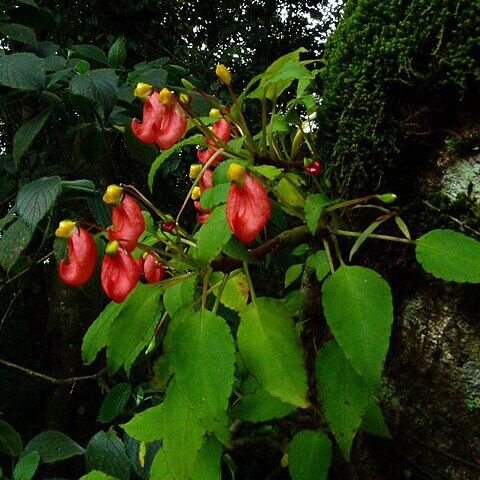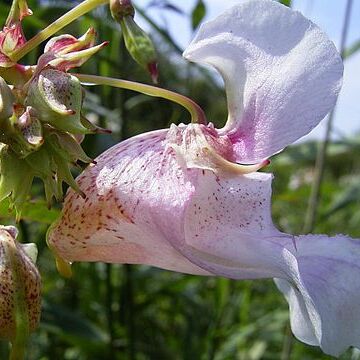Herbs annual or perennial [rarely epiphytic or subshrubs]. Stems erect or procumbent, usually succulent, often rooting at lower nodes. Leaves simple, alternate, opposite, or verticillate, not stipulate, or sometimes with stipular glands at base of petiole, petiolate or sessile, pinnately veined, margin serrate to nearly entire, teeth often glandular-mucronate. Flowers bisexual, protandrous, zygomorphic, resupinate to through 180° in axillary or subterminal racemes or pseudo-umbellate inflorescences, or not pedunculate, fascicled or solitary. Sepals 3(or 5); lateral sepals free or connate, margins entire or serrate; lower sepal (lip) large, petaloid, usually navicular, funnelform, saccate, or cornute, tapering or abruptly constricted into a nectariferous spur broadly or narrowly filiform, straight, curved, incurved, or ± coiled, swollen at tip, or pointed, rarely 2-lobed, rarely without spur. Petals 5, free, upper petal (standard) flat or cucullate, small or large, often crested abaxially, lateral petals free or united in pairs (wing). Stamens 5, alternating with petals, connate or nearly so into a ring surrounding ovary and stigma, falling off in one piece before stigma ripens; filaments short, flat with a scalelike appendage inside; anthers 2-celled, connivent, opening by a slit or pore. Gynoecium 4-or 5-carpellate, syncarpous; ovary superior, 4-or 5-loculed, each locule with 2 to many anatropous ovules; style 1, very short or ± absent; stigmas 1-5. Fruit an indehiscent berry, or a 4-or 5-valved loculicidal fleshy capsule, usually dehiscing elastically. Seeds dispersed explosively from opening valves, without endosperm; testa smooth or tuberculate.
Annual or perennial succulent herbs and subshrubs. Stems succulent, never woody, often rooting at the lower nodes, glabrous. Leaves alternate, opposite or whorled, usually petiolate, two distal glands present, margins often toothed, sometimes entire; blades very fleshy, drying membranous. Stipules usually absent. Inflorescences of axillary cymes or fascicles, or flowers solitary. Flowers bisexual, with bilateral symmetry. Sepals 5 (appearing or sometimes reduced to 3), usually 2 upper sepals small and mostly green, 2 lower sepals petal-like and 1 lower sepal fused into a petal-like spur that secretes nectar. Petals 5, partly to entirely fused, the uppermost usually flat or helmet-shaped, lower ones usually united in 2 pairs or wings; brightly coloured, white to pink to red to mauve or a combination of these. Stamens 5, reduced, alternating with petals, filaments and anthers united to form a tube at the tip, pollen released within the flower; anthers 2-celled, opening by a slit or pore. Ovary superior, with (4)5 locules; ovules many. Stigma 5-lobed, rupturing the stamina filaments or filament ring falling as stigma expands in fruit. Fruit a 4-or 5-valved fleshy capsule (Hydrocera, not in Australia, has a fleshy pseudo-berry), opening explosively, the valves coiling back. Seeds 10–20, smooth or tuberculate, brown, embryo straight.
Petals 5; the anterior one (apparently posterior in position in the mature flower) always large, flat or helmet-shaped, often dorsally carinate; the 4 lower ones usually connate in lateral pairs, very rarely free, usually deeply 2-lobed, rarely with the posterior lobe reduced to a small auricle
Sepals 3, rarely 5, deciduous, imbricate; the posterior one (apparently anterior in position by resupination) petaloid, large, funnel-shaped, obliquely navicular or bucciniform, nearly always with a nectariferous spur; the lateral ones usually small, green or coloured
Leaves simple, petiolate or sessile, verticillate or opposite or spirally arranged, pinnately veined with margins crenulate or serrate or denticulate and often with glanduliferous (tentacle-like) hairs; exstipulate or with stipular glands
Stamens 5, alternating with the petals; filaments flattened, connate above, closely attached to the ovary; anthers 2-thecous, connate or coherent, thus forming a crown round the ovary
Herbs, often with a suffrutescent habit, sometimes epiphytic, sometimes aquatic, glabrous or with an indumentum of simple hairs; stems herbaceous, succulent or rarely woody
Ovary superior, of 5 carpels, 5-locular, with axile placentation; ovules pendulous, anatropous, 3-many in a row on each placenta; style 1, usually very short; stigmas 1–5
Flowers bisexual, sometimes cleistogamous (often in certain species with both normal and cleistogamous ones in the same inflorescence), always zygomorphic
Fruit a 5-valved loculicidal capsule, with the valves opening elastically and coiling, rarely a berry (in the Asiatic genus Hydrocera)
Inflorescences usually axillary, more rarely of terminal racemes or pseudumbels or fascicles, or flowers solitary
Ovary superior, 5-celled, with axile placentas; stigmas 1–5, more or less sessile; ovules numerous
Sepals 3, rarely 5, coloured, imbricate, unequal, the lowermost hollowed out into a spur
Petals 3, the upper one outside, usually erect, concave, the lateral ones often 2-lobed
Succulent herbs; leaves alternate or opposite, simple, penninerved; stipules absent
Stamens 5; filaments short and broad; anthers 2-celled, connate around the ovary
Flowers zygomorphic, hermaphrodite, brightly coloured, solitary to subumbellate
Fruit a succulent capsule, opening elastically into 5 twisted valves
Seeds without endosperm and with straight embryo
Seeds without endosperm; embryo straight


